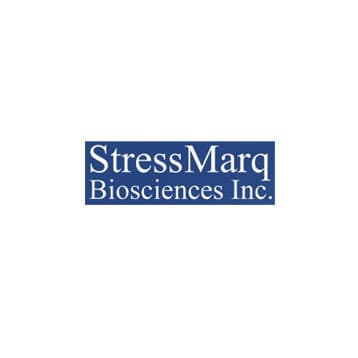
Supplier:
StressMarq Biosciences Inc.Cat no: SMC-129D
KDEL Receptor
Prices direct from StressMarq Biosciences Inc.
Quick response times
Exclusive Absave savings/discounts
SPECIFICATIONS
Catalog Number
SMC-129D
Size
100ug
Applications
ICC, IHC, IP, WB
Hosts
Mouse
Reactivities
Hum, Mouse, Rat, Bov, Can, Ch/Bird, Ham, Prc, Rabbit, Sheep
Form
Mouse Ascites fluid
Clone
KR-10
Gene Id
68137
Isotype
IgG1
Accession
NP_598711.1
Dilutions
1:1000 dilution was sufficient for detection by colorimetric analysis
References
1. Whiteman P., and Handford P.A. (2003) Hum Mol Genet\n2. Forthoffer N., et al. (2002) 12(7): 727-737.\n34(3): 209-219.\nJ Bioenerg Biomemb\n3. Aoe T., et al. (1997) EMBO J. 16: 7305-7316.\n4. Tang B.L., Wong S.H, Qi X.L. Low S.H., and Hong\nW. (1993) J. Cell
Swiss Prot
Q99JH8
Storage Temp
-20
Concentration
1mg/mL
Research Area
Chaperones, Organelle Markers
Shipping Temp
Blue Ice or 4
Storage Buffer
PBS pH7.2, 50% glycerol
Alternative Names
ERD2, ERD2.1, ERD21, HDEL, KDEL, KDEL R1, KDELR1, PM23
Scientific Background
The endoplasmic reticulum is part of a protein sorting pathway, or in essence, the transportation system of the eukaryotic cell. The majority of endoplasmic reticulum resident proteins are retained in the endoplasmic reticulum through a retention motif. T
Certificate Of Analysis
1ug/ml was sufficient for detection of KDEL receptor in 20ug monkey Vero cell lysate by colorimetric immunoblot analysis using Goat Anti-Mouse IgG:AP as the secondary.
Applications
ELISA, IP, WB
Hosts
Mouse
Reactivities
Hum
Applications
ELISA, ICC, IHC
Hosts
Mouse
Reactivities
Hum, Mouse, Rat, Bov
Applications
ELISA, ICC, IHC
Hosts
Mouse
Reactivities
Hum, Mouse, Rat, Bov
Applications
ELISA, ICC, IHC, WB
Hosts
Mouse
Reactivities
Hum
Applications
ELISA, ICC, IHC, WB
Hosts
Mouse
Reactivities
Hum
Applications
ELISA, ICC, IHC, WB
Hosts
Mouse
Reactivities
Hum, Mouse, Rat, Bov, Can, Ch/Bird, GP, Ham, Prc, Rabbit, Sheep
Applications
ELISA, ICC, IHC, WB
Hosts
Mouse
Reactivities
Hum, Mouse, Rat, Bov, Can, Ch/Bird, GP, Ham, Prc, Rabbit, Sheep
Hosts
Mouse
Reactivities
Hum, Mouse, Rat, Ch/Bird, GP, Prc
Latest promotions
Buy any polyclonal or monoclonal antibody from our extensive range of pre-made antibodies and for a limited time only receive a $50 discount!(T&C apply:...
New brilliant antibodies, and new lower prices!For flow cytometry reagents in general, \"bright is better.\" The violet-excitable BD Horizon™ BV421 and...
10% Discount on 2 Rabbit Polyclonal Antibody Service. With over 20 years experience, SDIX has developed into the premier US custom antibody producer,...
For the past decade scientists have extensively used ATS secondary toxin conjugates to make their own targeted toxins for in vitro use.The ability to combine...
We're so sure that you'll prefer Cayman Assay kits over your present brand that we're willing to give you a free assay kit to prove it!
Did your supplier increase the price of Fetal Bovine Serum? Did they substitute the US Origin with USDA? Well say no more! Innovative Research is still...
Bulk Cytokines with Custom Vialing.20 - 50% off cytokines, growth factors, chemokines and more...For a limited time Cell Sciences is offering substantial...
Are you planning to have a customised antibody made for your research?Since 2000, Everest has been producing a catalog containing thousands of affinity...
Top suppliers
Agrisera AB
11 products
Biotrend
Biosensis
969 products
ABBIOTEC
3011 products
SDIX
1 products
Spring Bioscience
2291 products
Cell Signaling Technology
4976 products
Rockland Immunochemicals, Inc.
7592 products
Boster Immunoleader
1533 products
OriGene Technologies Inc.
5281 products
Maine Biotechnology Services
227 products
BD (Becton, Dickinson and Company)
1 products
ABNOVA CORPORATION
Randox Life Sciences
1502 products















